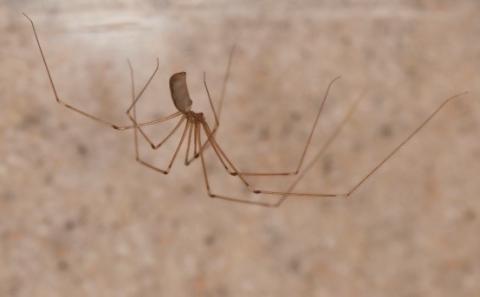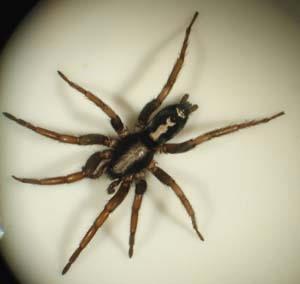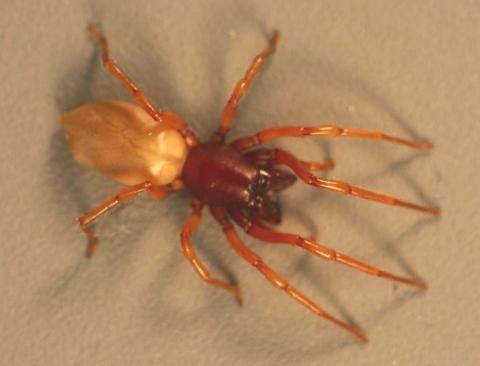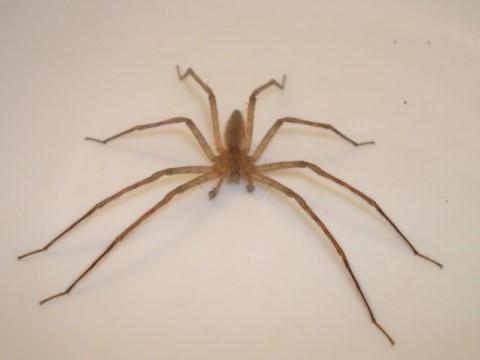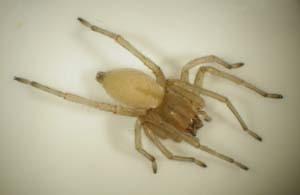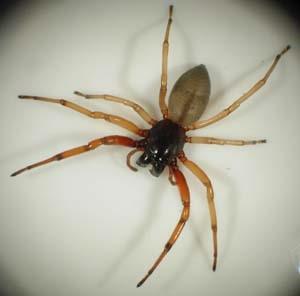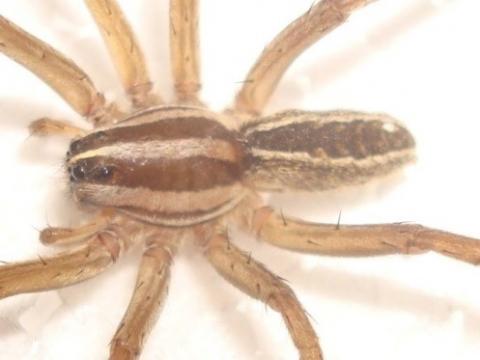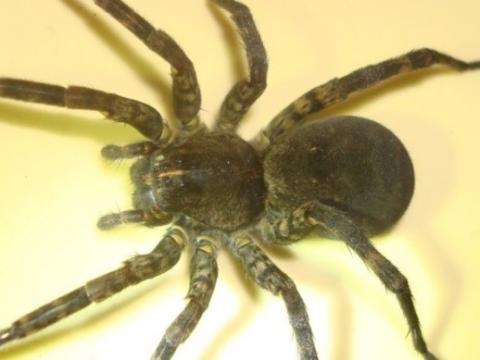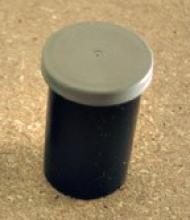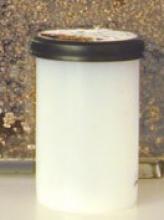You are here
Brown Recluse Project
The Indiana and Ohio Brown Recluse Project
Brian Foster, Animal technician
The brown recluse (Loxosceles reclusa) can be found in almost any county in the southern half of Indiana and becomes less common as you travel north. In Ohio, the brown recluse is found in the southwest portion of the state and becomes less common as you travel north and east. Cold winter weather limits the northern distribution of recluses in the wild, but some populations accidentally transported outside the natural range may persist in climate-controlled buildings. An introduced species of recluse spider, the Mediterranean Recluse (Loxosceles rufescens), has been documented in both Indiana and Ohio but little is known about its distribution in the bi-state region. The brown recluse and Mediterranean recluse look almost identical differing at the microscopic level.

Recluses are rarely found outside the area shaded in red. Such encounters should not be interpreted as a broadening of the species typical range. Map by Dr. Richard Vetter
Identification
The most common means of identification of brown recluses is to look for the “violin” pattern on the spiders back (cephalothorax). This method, although useful in identification, is not fool-proof because many other species of spiders found in Indiana and Ohio homes have markings on their backs. Here are some tips for brown recluse identification:
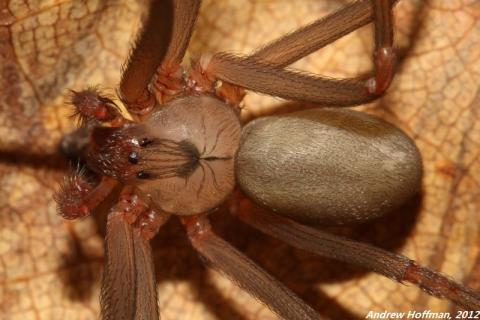
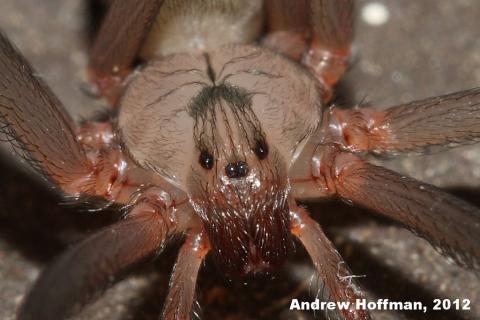
Eye arrangement- brown recluse have 6 eyes arranged in three pairs or dyads. This feature can easily be seen with a good magnifying glass, hand lens, or dissecting microscope.
Size: an adult brown recluse is about the size of a quarter, including its legs.
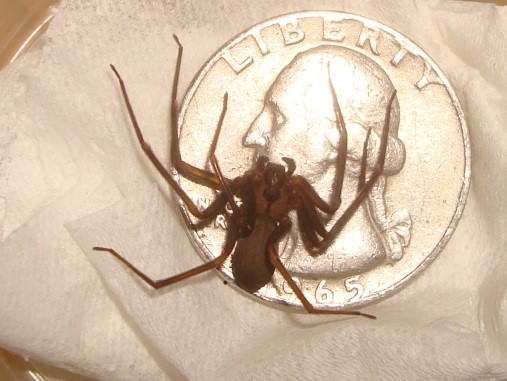
Projected Goal of this Study
The brown recluse is a spider of medical significance. In rare instances, its bite can cause severe tissue damage. A better understanding of the distribution of the brown recluse in Indiana and Ohio can assist the medical community, pest control community, and the general public in avoiding misidentifications and misdiagnoses which could delay proper treatment for other medical conditions. Dramatized photos and dubious stories on the internet have elevated public concern about brown recluses leading the general public to believe the spider occurs throughout the United States.
IF YOU ARE READING THIS, SEND ME YOUR SPIDERS!
In order to better understand where brown recluse are found in Indiana and Ohio then please send me your spiders! If you suspect you have brown recluse please send me a specimen for verification. Compare suspected recluses to the photos provided on this web page to rule out other species. Spiders from anywhere in Indiana and Ohio are accepted. Any persons interested, please send in your spiders for identification.
|
It's NOT a Brown Recluse IF: 1) It’s found in a WEB! Brown recluses do not spin a web to catch prey; they spin silk retreats, but do not form a typical recognizable web. |
Common spiders found in and around homes that are often mistaken for brown recluses:
|
Cellar spider (Pholcus phalangioides) |
Parson's Spider |
|
Woodlouse Hunter |
Pisaurina mira Fishing Spider |
|
Sac spider, Cheiracanthium |
Trachelas tranquillus |
|
Wolf Spider Rabidosa rabida |
Wolf Spider, Tigrosa aspersa |
Capturing spiders:
DISCLAIMER: Indiana State University and Ohio State University assumes no responsibility for any injuries sustained by individuals choosing to handle live spiders. Four species of spiders are medically significant in Indiana and Ohio: brown recluse, Mediterranean recluse, northern black widow, and southern black widow. Learn to recognize these spiders!
Recommended method of capture Spiders can be corralled into a container without direct contact. Slide a piece of paper under the jar and spider, then invert the jar and tap the spider to the bottom of the jar. Quickly remove the paper and seal with the lid. This method minimizes damage to the spider.
Sticky / Glue Traps for Capturing Spiders: The best placement of traps is flat on the floor against a wall or other object. Recluses tend to prefer clutter and relatively undisturbed areas (a garage, barn, basement, attic). Leave traps out for several days or even weeks, and place two or three per room for maximum control. Many traps have space to write information on them -- you can put your collecting information there. Be sure when you pick up the traps not to touch the spiders. They can survive for days or weeks on a trap, and although immobilized by the glue, they may be quite alive and capable of biting. When the traps are full of bugs or have some spiders on them, you can then place them a box, padded to protect the specimens during shipment, and mail them.
|
How to Submit a Spider Specimen 1. Euthanizing the spider: place the spider in rubbing alcohol, or if that seems unpleasant, put the spider in the freezer overnight. Remove spider from freezer, allow to thaw, place in isopropyl rubbing alcohol. 2. Preserving the spider: soak the spider for at least 48 hours in isopropyl rubbing alcohol or ethyl alcohol. 3. Labeling the spider: The most important thing is to remember to include a label INSIDE the container with the spider, written in PENCIL (not ink). on the label you need: date, exact locality, collector's name, habitat (where you found it) [do not attached to the outside of the container; they usually peel off. Pencil is better than ink because it will not dissolve in alcohol] 3. Mailing the spider: After the spider has been soaked in alcohol, it will remain preserved for some time. Pour off the alcohol then put the moist spider and an alcohol-moist tissue or piece of paper towel in the container with the pencil label. Put this container into a sealed plastic bag to avoid any seepage. Mail the spider in a well- padded envelope or small box. The US Post Office will NOT accept mail with flammable liquid which is why you need to pour off the liquid and ensure that no moisture leaks out of the vial. SUITABLE CONTAINERS: Consider the small plastic snap lid film canisters. Remember you need to use plastic because glass may break in the mail. The container must be waterproof and non-crushable so that the spider doesn't dry out or get squashed in the mail. On one side of the package, write in large capital letters, BIOLOGICAL SPECIMEN, NOT OF COMMERCIAL VALUE. Do not mail LIVE spiders. US Postal Service regulations prohibit mailing live venomous spiders.
Send spiders to:Brian Foster 600 Chestnut St. S. 224 Terre Haute, IN 47809 Contact info: brian.foster@indstate.edu For a quick response, provide an e-mail address. Spiders will be identified to family as soon as possible and you will receive a note via e-mail or postal service telling you the identity of your spider(s). |
|
Due to the presence of the Mediterranean Recluse Spider, photo submissions cannot be identified to the species level. Any recluse spider from Indiana or Ohio must be examined under a microscope to separate the two species.
Bite Diagnosis/Misdiagnosis |
|
Be aware that doctors throughout the United States have diagnosed "brown recluse bites" as the cause of wounds in states where brown recluse have never been collected. Diagnosing a recluse bite merely from the presence of a wound or ulcerating sore is virtually impossible. Many medical conditions can create open sores, blisters, and dermonecrosis (literally "dying skin"). One of the more common causes of dermonecrosis is MRSA, or methicillin-resistant Staphylococcus aureus, a bacterium that is resistant to common antibiotics. To confirm a diagnosis as even a possible recluse bite, the presence of the spider in the area frequented by the victim must be established. For certainty, the spider suspected of causing the bite should be killed and brought to the doctor with the victim. Often, this is not possible, but where there is one spider, generally there are more and it should not be difficult to capture some by placing a few sticky traps in the area. |
Avoid Being Bitten
Recluses are not aggressive and tend to run away from a disturbance or threat. Bites accidently happen when people grab a spider without seeing it, or when they put on clothing where a recluse has taken up residence. Recluse prefer areas that haven't been disturbed for a long time- clothes you haven't worn in months (especially shoes and gloves), boxes in garages and attics, woodpiles, rock piles, etc. Keeping a few sticky traps where the wall meets the floor in the rooms you inhabit regularly will keep wandering recluses in check and make you feel more comfortable each time you see one stuck helplessly on the trap.
Special thanks to Dr. Donna Selman for granting permission to create this webpage, Andrew Hoffman for photos, and Maria Forsythe for maintaining this webpage.
SOURCES
Dr. Richard Bradley (Ohio State University), Dr. Kenneth Cramer (Monmouth College, IL), Dr. Richard Vetter (University of California, Riverside)
Links:
http://department.monm.edu/biology/recluse-project/
http://spiders.ucr.edu/myth.html
http://osumarion.osu.edu/SpiderWeb/ProvisionalSpiderList.htm

